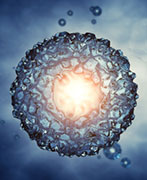- Big Health Care Disparities Persist Across the U.S., New Report Finds
- Teens Often Bullied Online About Their Weight: Study
- Work That Challenges Your Brain Helps You Stay Sharp With Age
- Urine Test Might Spot Head-and-Neck Cancers Early
- Many Seniors Are Overmedicated, But ChatGPT Might Prevent That
- Antipsychotics May Do Great Harm to People With Dementia: Report
- Two-Drug Combo Curbs Drinking for People Battling Severe Alcoholism
- Most Homeless Americans Are Battling Mental Illness
- FDA Recalls Heart Failure Devices Linked to Injuries and Deaths
- COVID Does Not Spur Asthma in Kids, Study Finds
New Test May Spot Which Embryos Stand Greatest Chance of Survival


MONDAY, Oct. 14Doctors have unveiled a new test for determining which embryos have the best chance of survival.
The amount of mitochondria found in the cells of an embryo appeared to be a marker of its health, doctors reported Monday at the International Federation of Fertility Societies and American Society for Reproductive Medicine annual meeting in Boston. Research presented at meetings is considered preliminary until published in a peer-reviewed medical journal.
Higher levels of mitochondria — the “powerhouses” of cells — seemed to indicate an embryo was under stress and less likely to successfully implant in a woman’s uterus, said study co-author Dr. Dagan Wells, a scientific leadership fellow at Oxford University in England.
The researchers were able to establish a mitochondrial threshold above which they felt sure an embryo wouldn’t be able to implant in a uterus, he said.
By selecting the healthiest embryos, doctors hope to cut down on unsuccessful implantations and miscarriages.
Doctors already can screen embryonic cells to make sure they have the proper number of chromosomes. Previous research has found that if embryos have more or fewer than the usual 46 chromosomes — 23 from the mother and 23 from the father — they rarely survive implantation, Wells said.
When doctors add the mitochondria test to the chromosome count, they will be able to increase the rate of successful embryo implantation from between 60 percent and 65 percent to as high as 80 percent, he said.
“We think this will get us to a significantly improved birth rate, and we are planning clinical trials,” Wells said.
Dr. Joe Leigh Simpson, president of the International Federation of Fertility Societies, hailed the new findings as creating a “better mouse trap” for screening embryos.
“We can simply add mitochondrial assessment at the same time as chromosomal screening, and better address the disappointment of why we don’t get a success,” Simpson said. “I would look upon this as providing transformative information. There would be fewer cycles required to produce a baby that one could take home.”
In the 30 years since the discovery of in vitro fertilization, more than 5 million babies have been born worldwide due to the technique. “In any classroom, there’s likely to be one or two IVF children among them,” Wells said.
But the process is still relatively inefficient. “Only about 30 percent of IVF cycles actually produce a baby,” Wells said. “Many patients have to undergo multiple IVF cycles before they finally achieve that much-desired baby.”
Researchers decided to look at mitochondria as a possible culprit for unsuccessful implantation. Mitochondria are responsible for creating usable forms of energy for a cell. They also are involved in key cellular processes such as cell signaling, cell differentiation and programmed cell death.
The doctors reviewed the amount of mitochondrial DNA present in 219 embryos produced by 59 couples.
They found that mitochondrial DNA was elevated in the embryos produced by women in their late 30s and 40s, and also was elevated in embryos with the wrong number of chromosomes. The embryos that had the worst chromosomal abnormalities had the highest levels of mitochondrial DNA.
Researchers then implanted embryos that appeared healthy, regardless of their mitochondria levels. “These are embryos we would have high hopes for,” Wells said. “They look good under the microscope. They did not have chromosome abnormalities.”
However, only half of the implantations produced a baby.
Based on those findings, doctors established a threshold amount of mitochondrial DNA. “Embryos above that level never implant,” Wells said. “About 25 percent of embryos that are chromosomally normal but fail to implant have these elevated levels of mitochondrial DNA.”
They verified their findings by repeating the test on a second set of embryos using next-generation genetic sequencing. “It appears this is a genuine phenomenon,” Wells said.
Chromosome screening is an expensive procedure, costing about $3,000, but Wells said a mitochondria screen could be added to the same procedure without increasing the cost.
“The mitochondrial screen could potentially be a free add-on on top of chromosomal screening,” he said, given that both require a physician to take a few cells from the embryo and pass them on to a genetics lab. “Once you’ve got those cells, you might as well do as much as you can with them.”
Wells warned, however, that the screen only sorts the potential viability of embryos. “These kind of tests aren’t a magic bullet. They aren’t going to make the embryos any more viable,” he said. “In some IVF cycles, you’re not going to get any viable embryos.”
More information
For more on in vitro fertilization, visit the U.S. National Institutes of Health.
Source: HealthDay
Copyright © 2024 HealthDay. All rights reserved.










